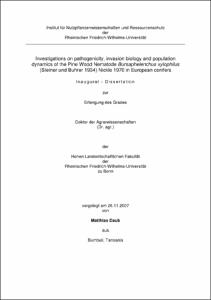Investigations on pathogenicity, invasion biology and population dynamics of the Pine Wood Nematode Bursaphelenchus xylophilus (Steiner und Buhrer 1934) Nickle 1970 in European conifers


| dc.contributor.advisor | Sikora, Richard A. | |
| dc.contributor.author | Daub, Matthias | |
| dc.date.accessioned | 2020-04-11T14:23:18Z | |
| dc.date.available | 2020-04-11T14:23:18Z | |
| dc.date.issued | 2008 | |
| dc.identifier.uri | https://hdl.handle.net/20.500.11811/3263 | |
| dc.description.abstract | The objectives of the present study were to identify potential European host trees for the Pine Wood Nematode (PWN) and to investigate the interrelationship between PWN, host trees and temperature. Inoculation experiments with a life stage mixture of 2400 to 4000 B. xylophilus per sapling were conducted with three to four year old saplings in greenhouse and climate chambers adjusted at 25 C. To evaluate the development of Pine Wilt Disease (PWD), symptoms were assessed in six wilt classes and water content of wood and needles were recorded. Nematodes were extracted from shoots and roots using a modified Baermann funnel technique. To determine the effect of B. xylophilus on mortality of P. sylvestris, nematodes were inoculated in 140 saplings with seven densities: 100, 300, 800, 2400, 4000, 6000, 10000. Nematodes were extracted four and twelve weeks after inoculation or at plant death if that occurred before end of experiment. Inoculum densities had no influence on mortality rate which was in general high (70-90 %). Higher population densities in saplings after four weeks were related to higher inoculum densities. After screening 13 conifer species, P. sylvestris, P. cembra, P. nigra, P. strobus, P. pinaster, P. radiata, P. mugo and L. decidua could be identified as potential sensitive and susceptible hosts for B. xylophilus isolates from Portugal, China and North America. L. kaempferii was moderately susceptible and P. pinea was only susceptible against the isolate from Portugal. A. alba, P. abies and P. halepensis were no hosts for B. xylophilus. Migration and population dynamics of PWN was studied on P. sylvestris saplings. Plants were divided into 17 segments and nematodes were extracted from each segment at nine sampling dates within a 27 day period after inoculation. The nematode population density per sapling reached three population peaks, 12, 19 and 27 days after inoculation. PWN could be isolated from all 17 segments six days after inoculation. Results indicate that B. xylophilus first migrate rapidly throughout the host before building up a high population level. Nematodes were found to develop several overlapping populations in time depending on the area of the sapling. Four consecutive stages of nematode invasion were observed: (1) Early migration, (2) Distribution and colonisation of all plant parts, (3) Population build up and (4) Retreat into the root-system. The effect of temperature on population dynamics of PWN and pathogenicity towards P. sylvestris, L. decidua and P. abies was studied by inoculation of sapling with 4800 nematodes. Experiments were carried out in climate chambers at 15°C, 20°C and 25°C. Nematodes were extracted from shoots and roots at seven sampling dates during a 61 day period. Temperature had a major effect on the population dynamics of B. xylophilus in both susceptible conifer species. Temperature had no influence on the pathogenicity of PWN, as maximum mortality in P. sylvestris and L. decidua was reached when temperature exceeded 20°C. However no wilt symptoms were detected at 15°C in any conifer species. The population in P. sylvestris increased to approximately 4000 nematodes per gram dry matter in shoots at 25°C. At 20°C the maximum population density in shoots was approximately 2500 nematodes per gram dry matter. A threshold population density of B. xylophilus must be reached for induction of irreversible wilt in P. sylvestris. | en |
| dc.description.abstract | Untersuchungen zur Pathogenität, Invasionsbiologie und Populationsdynamik des Kiefernholznematoden Bursaphelenchus xylophilus (Steiner und Buhrer 1934) Nickle 1970 in Europäischen Koniferen | en |
| dc.language.iso | eng | |
| dc.rights | In Copyright | |
| dc.rights.uri | http://rightsstatements.org/vocab/InC/1.0/ | |
| dc.subject | Nematalogie | |
| dc.subject | Bursaphelenchus xylophilus | |
| dc.subject | Pinewoodnematode | |
| dc.subject | Pathogenicity | |
| dc.subject | Population dynamics | |
| dc.subject.ddc | 570 Biowissenschaften, Biologie | |
| dc.subject.ddc | 580 Pflanzen (Botanik) | |
| dc.title | Investigations on pathogenicity, invasion biology and population dynamics of the Pine Wood Nematode Bursaphelenchus xylophilus (Steiner und Buhrer 1934) Nickle 1970 in European conifers | |
| dc.type | Dissertation oder Habilitation | |
| dc.publisher.name | Universitäts- und Landesbibliothek Bonn | |
| dc.publisher.location | Bonn | |
| dc.rights.accessRights | openAccess | |
| dc.identifier.urn | https://nbn-resolving.org/urn:nbn:de:hbz:5N-14685 | |
| ulbbn.pubtype | Erstveröffentlichung | |
| ulbbnediss.affiliation.name | Rheinische Friedrich-Wilhelms-Universität Bonn | |
| ulbbnediss.affiliation.location | Bonn | |
| ulbbnediss.thesis.level | Dissertation | |
| ulbbnediss.dissID | 1468 | |
| ulbbnediss.date.accepted | 25.04.2008 | |
| ulbbnediss.institute | Landwirtschaftliche Fakultät : Institut für Nutzpflanzenwissenschaften und Ressourcenschutz (INRES) | |
| ulbbnediss.fakultaet | Landwirtschaftliche Fakultät | |
| dc.contributor.coReferee | Goldbach, Heiner E. |
Dateien zu dieser Ressource
Das Dokument erscheint in:
-
E-Dissertationen (1110)




